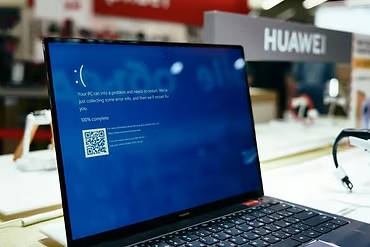Your cart is currently empty!
Few things are more unsettling than your computer suddenly freezing, displaying a cryptic error message on a blue screen, and then restarting. This dreaded “Blue Screen of Death” (BSOD) can strike fear into the hearts of even seasoned computer users, making you wonder if your precious data is lost forever or if your PC is beyond repair.
At AS Computer Solutions here in Onoway, we understand the panic a BSOD can cause. The good news? While it looks alarming, a blue screen crash doesn’t always mean the end for your computer. Often, it’s a critical error that Windows encounters, forcing a shutdown to prevent further damage. Understanding what causes them and how to respond can save you a lot of stress and potentially, a trip to the repair shop.
So, before you panic or consider buying a new computer, let’s demystify the blue screen and walk through some actionable steps.
✅ Step 1: Understand What a Blue Screen Means
A Blue Screen of Death (BSOD), also known as a stop error, indicates that Windows has encountered a critical problem that it cannot recover from. When this happens, Windows stops running to prevent data corruption or further hardware damage. The blue screen displays a stop code and sometimes a brief message that can offer clues about the underlying issue.
Common causes of a BSOD include:
Driver issues: Outdated, corrupt, or incompatible device drivers are a frequent culprit.
Hardware failures: Faulty RAM, hard drives, graphics cards, or other components.
Software conflicts: Incompatible programs or software bugs.
Malware or virus infections: Malicious software can corrupt system files.
Overheating: Excessive heat can cause hardware to malfunction.
Corrupted Windows system files: Critical system files can become damaged.
🛠️ Step 2: Immediate Actions When a BSOD Occurs
The first thing to do when you see a BSOD is to note down the stop code (e.g., CRITICAL_PROCESS_DIED, MEMORY_MANAGEMENT, DRIVER_IRQL_NOT_LESS_OR_EQUAL). This code is your best clue for diagnosing the problem. If possible, also note any file names mentioned.
After the BSOD, your computer will typically restart automatically. If it doesn’t, manually power it off and on again.
📌 Step 3: Targeted Troubleshooting After Restart
Once your computer restarts, or if you can get into Windows, it’s time for some targeted troubleshooting.
🔄 Reboot Your Computer (Again)
It sounds simple, but sometimes a one-off glitch can trigger a BSOD. A clean restart might resolve it if the issue isn’t persistent.
💾 Check for Recent Changes
Did you just install new software, hardware, or a driver before the BSOD occurred?
If you installed new software: Try uninstalling it.
If you updated a driver: Consider rolling back the driver to a previous version. You can do this through Device Manager:
Press Windows + X and select Device Manager.
Locate the device whose driver you recently updated.
Right-click the device, select Properties, go to the Driver tab, and click Roll Back Driver if available.
🔍 Check for Windows Updates
Sometimes, a BSOD can be caused by a bug that has already been patched by Microsoft.
Go to Settings > Windows Update and check for and install any available updates.
🧹 Run a System Scan for Malware
Malware can corrupt system files and lead to BSODs.
Run a full scan with your antivirus software. If you don’t have one, Windows Defender is built into Windows and can perform a scan.
🛠️ Step 4: Advanced Troubleshooting Steps
If the problem persists, or if you can’t even boot into Windows normally, you’ll need to try more advanced steps.
🧰 Scenario 1: Frequent BSODs or Can’t Boot Normally
If your computer keeps crashing or won’t boot into Windows, try Safe Mode. Safe Mode starts Windows with a minimal set of drivers and services, which can help you diagnose if a third-party application or driver is causing the issue.
How to Boot into Safe Mode:
Windows 10/11: If Windows crashes multiple times during startup, it should automatically enter the Windows Recovery Environment. From there, you can navigate to Troubleshoot > Advanced options > Startup Settings > Restart, and then select Safe Mode with Networking (or just Safe Mode).
Alternatively, if you can briefly get into Windows: Hold down the Shift key while clicking Restart from the Start Menu. This will also take you to the Windows Recovery Environment.
Once in Safe Mode:
Uninstall recently installed software/drivers.
Update or roll back drivers as described above.
Run System File Checker (SFC): Open Command Prompt as administrator and type sfc /scannow. This will scan for and repair corrupted Windows system files.
Run Check Disk (CHKDSK): In Command Prompt as administrator, type chkdsk /f /r. This checks your hard drive for errors.
📈 Check for Hardware Issues
Hardware problems are a common cause of BSODs.
Test RAM: Faulty RAM is a frequent culprit. You can use the Windows Memory Diagnostic Tool: Type “Windows Memory Diagnostic” in the Start search bar and follow the prompts.
Check Disk Health: Use a utility like CrystalDiskInfo (a free third-party tool) to check the health of your hard drive or SSD. Windows also has a built-in error checking tool.
Inspect for Overheating: Ensure your computer’s fans are working and not blocked by dust. Monitor CPU and GPU temperatures using software like HWMonitor.
🔄 Scenario 2: Specific Stop Code Troubleshooting
If you consistently get the same stop code, search online for that specific code. For example, search for “DRIVER_IRQL_NOT_LESS_OR_EQUAL fix” or “0x000000D1 error.” This will often lead you to specific solutions for that error, such as updating a particular driver.
🔙 System Restore
If the BSOD started recently and you’ve tried other fixes, a System Restore can revert your system files, installed applications, and registry to an earlier point in time when your computer was working correctly.
Type “Create a restore point” in the Windows search bar, then click System Restore and follow the prompts.
🧰 Still No Luck? Bring It to the Pros
If you’ve tried these steps and your computer is still crashing with a blue screen, don’t stress—AS Computer Solutions is here to help. Diagnosing persistent BSODs can be complex, often requiring specialized tools and expertise to pinpoint the exact cause, especially if it’s a subtle hardware issue or deeply embedded software conflict.
We can:
Run advanced diagnostics to identify system, driver, or hardware conflicts that are hard to detect.
Thoroughly test RAM, hard drives, and other components for underlying failures.
Perform a clean reinstallation of Windows if necessary, ensuring all drivers are correctly installed.
Check for underlying issues like malware, system corruption, or overheating that might be subtle.
Recommend reliable replacement options if a hardware component has failed.
🏡 Local. Reliable. Ready to Help.
Serving Onoway and surrounding communities, AS Computer Solutions is your go-to for friendly, affordable tech support. Don’t let a blue screen crash leave you in despair. Trying the steps above can often resolve the issue, but if you’re still stuck or uncomfortable with the troubleshooting process, we’re just a call away. We’ll get your computer—and your peace of mind—back on track.
Call or visit us today:
📞 (780) 967 0215
📍 Onoway, Alberta


Leave a Reply